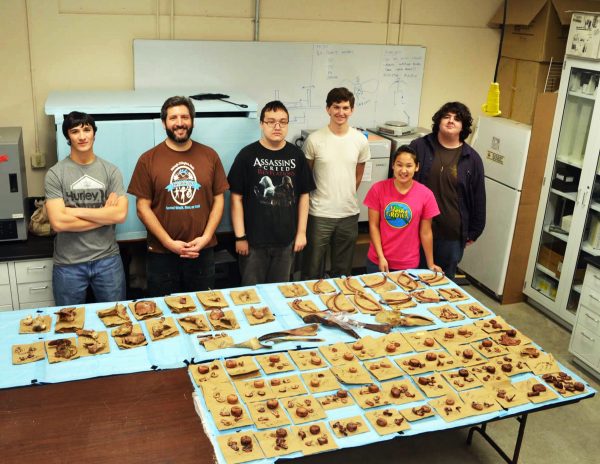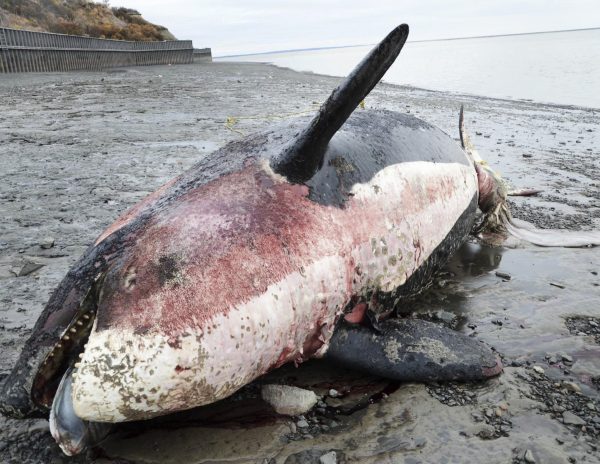Orca skeleton project nears goal at Bristol Bay Campus
May 17, 2016
Jeff Richardson
907-474-6284
Nearly five years after a pregnant orca whale washed ashore near Dillingham, a project
at the University of Alaska Fairbanks Bristol Bay Campus is close to offering an unprecedented
view of its fetus.

After hours spent meticulously cleaning, sorting and documenting hundreds of bones, university officials and Dillingham High School students are nearing their goal of reproducing the fetus’ skeleton with the help of a 3-D scanner and printer.
The long and unlikely project started in October 2011 when three killer whales swam up the Nushagak River near Dillingham, became stranded and died.
One of the whales immediately became a source of fascination for residents of the Southwest Alaska community. A local tribal organization, Nunamta Alukestai, coordinated a hasty plan to butcher and store the skeleton.
A necropsy determined the orca was pregnant. The soft tissue of the nearly full-term, 6-foot-long fetus was too fragile to be preserved, but its bones could be stored for future study.
“At the very beginning, when we were cutting up the mother whale, everyone was aware of the carcass,” said Clint Reigh, a UAF academic advisor who worked as a high school teacher in Dillingham at the time. “Anyone who could handle the smell was invited to come and help.”
Reconstructing the fetus skeleton grew into a long-term partnership with the Bristol Bay Campus in 2012. Combining disciplines as diverse as biology, computer studies and art, the project provided a bridge between the Dillingham campus and local high school students seeking course credits and jobs.

Reigh, Dillingham High School teacher Nathan Coutsoubos and Kimberly Williams, executive director of Nunamta Aulukestai, have spent the past five years working together to push the project forward.
“It fit into a couple of our objectives — working with the high school and setting some career pathways,” said Bristol Bay Campus Director Deborah McLean. “It fits in with art, scientific illustration, and it just kind of all worked with the programs that we wanted to offer.”
Assembling an orca fetus, however, presented a unique set of challenges. Reigh couldn’t find another example of a reconstructed killer whale fetus skeleton anywhere else in the world.
Students practiced with the bones of an otter, fox and lynx — stripping them down, taking the skeletons apart and then reassembling them. Lee Post, a Homer resident and skeletal expert known as “Bone Man,” lent his knowledge of techniques for articulating bones.
Many of the bones in the fetus hadn’t entirely fused when it was found, which made the skeleton much more complicated to assemble. In some cases, an unformed vertebrae is made up of five separate bones. The skull alone consists of roughly 30 extremely fragile pieces. In all, Reigh said, they range from about the size of a pencil eraser to a large boomerang-shaped bone.

Each bone requires a unique scanning technique. Some, which are the shape of a small cookie, take two simple 20-minute scans before they're reproduced in plastic by the 3-D printer. Other bones have passageways or holes in them, requiring images from many different angles.
“At that point, it becomes almost an art in acquiring the scan,” Reigh said.
Reigh said all of the bones could be printed out as early as this month. At that point, teams will work to piece together the skeleton with the fabricated plastic pieces, which are much more durable than the fragile bones.
“The bones are very porous and very fragile,” he said. “I think it’s in our best interest to practice on the plastic bones before we try to assemble the fetal skeleton.”
Once the model is complete, Bristol Bay Campus officials hope to work with researchers who want the rare opportunity to check out an orca fetus skeleton. But in a journey that has often involved the unexpected, McLean said they’re open to new directions.
“We’re always going, ‘What’s next?’” she said with a laugh. “This is experimental for us.”


